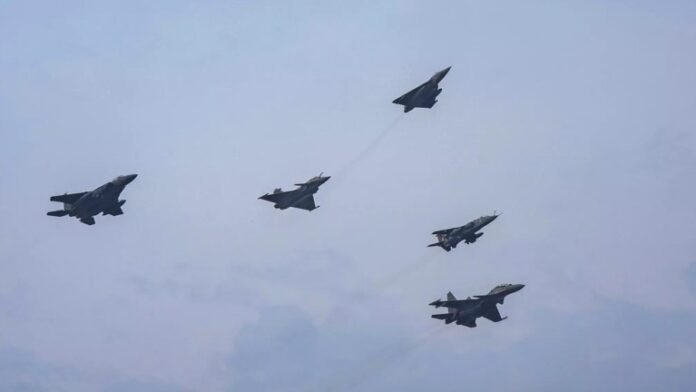The Indian Air Force (IAF) conducted a large-scale military exercise named ‘Aakraman’ amidst rising tensions with neighboring Pakistan. The exercise, which took place in April 2025, involved multiple air force assets, including fighter jets, transport aircraft, and drones, simulating a high-intensity conflict scenario. With tensions along the India-Pakistan border escalating, the Aakraman exercise demonstrates the IAF’s capability to execute quick, decisive airstrikes and maintain air dominance in a hostile environment.
Strategic Significance of ‘Aakraman’
The timing of ‘Aakraman’ is crucial as it comes at a time of heightened security concerns in the region, with increasing skirmishes between Indian and Pakistani forces. The exercise serves as a show of strength, both for national defense and as a deterrent to any potential adversaries. The IAF’s focus on rapid deployment and precise targeting underscores its preparedness to handle threats on both the western and northern borders of India.
‘Aakraman’ is designed to test the Air Force’s ability to deploy its air assets under complex, real-time battlefield conditions, using a combination of conventional warfare tactics and advanced technology. The exercise also aims to evaluate the coordination between air force units and ground forces, ensuring seamless operations during joint military operations.
Key Features of the Exercise
The ‘Aakraman’ exercise covered a range of scenarios involving simulated strikes on enemy targets, suppression of enemy air defenses (SEAD), air superiority missions, and precision strikes on high-value targets deep inside enemy territory. The IAF’s multi-role fighter jets, such as the Sukhoi Su-30MKI, Mirage 2000, and the Tejas Light Combat Aircraft, played a critical role in these operations.
The exercise also tested the use of drones for surveillance and precision strikes, a vital tool in modern warfare. The IAF’s drone operations demonstrated the effective use of unmanned aerial vehicles (UAVs) to gather intelligence, carry out real-time reconnaissance, and engage targets with high accuracy.
A key focus of the exercise was the integration of new-age technologies and tactics. The Indian Air Force is increasingly adopting cyber capabilities, electronic warfare, and network-centric operations, which were all part of the exercise. This allowed the IAF to test its ability to operate in a contested electromagnetic spectrum and execute operations while managing cyber threats.
Role of Indian Air Force in Indo-Pak Tensions
The Indian Air Force plays a crucial role in India’s defense strategy against Pakistan. With air superiority being critical in any conflict scenario, the IAF’s ability to strike swiftly and effectively ensures that India can deter or respond to any aerial or ground-based threats.
In recent months, tensions have flared between the two countries due to military skirmishes and increased cross-border infiltrations. Pakistan’s air force has also been conducting exercises in the region, prompting India to enhance its military preparedness. ‘Aakraman’ serves not only as a training exercise but also as a signal of India’s ability to safeguard its sovereignty and respond to any provocations from across the border.
Enhanced Capabilities and Future Preparedness
The IAF’s increasing focus on rapid response and technological integration is a testament to its evolving strategy to stay ahead of adversarial forces. The inclusion of cutting-edge technologies like stealth fighters, advanced radar systems, and smart bombs during ‘Aakraman’ highlights the Air Force’s modernization efforts, ensuring it remains a formidable force in the region.
Moreover, the success of this exercise also lays the groundwork for future operations that may involve multinational forces. The IAF’s collaboration with other branches of the military, such as the Indian Army and Indian Navy, during this exercise reflects India’s growing emphasis on joint operations and inter-service cooperation. This integrated approach will be vital in future conflict scenarios where swift coordination between land, air, and naval forces is essential.
Conclusion
The ‘Aakraman’ exercise by the Indian Air Force comes at a critical juncture, as tensions with Pakistan remain high. The exercise demonstrates India’s robust air defense capabilities, showcasing a highly trained and modernized air force ready to meet any threats. As the IAF continues to enhance its operational readiness with advanced technologies, exercises like ‘Aakraman’ reinforce the strategic deterrence in the region.
India’s air force remains one of the key pillars of national security, and its ability to conduct operations with precision and speed is vital in ensuring the nation’s safety. With rising tensions in the region, the Indian Air Force’s preparedness will continue to play a central role in safeguarding India’s airspace and interests.

